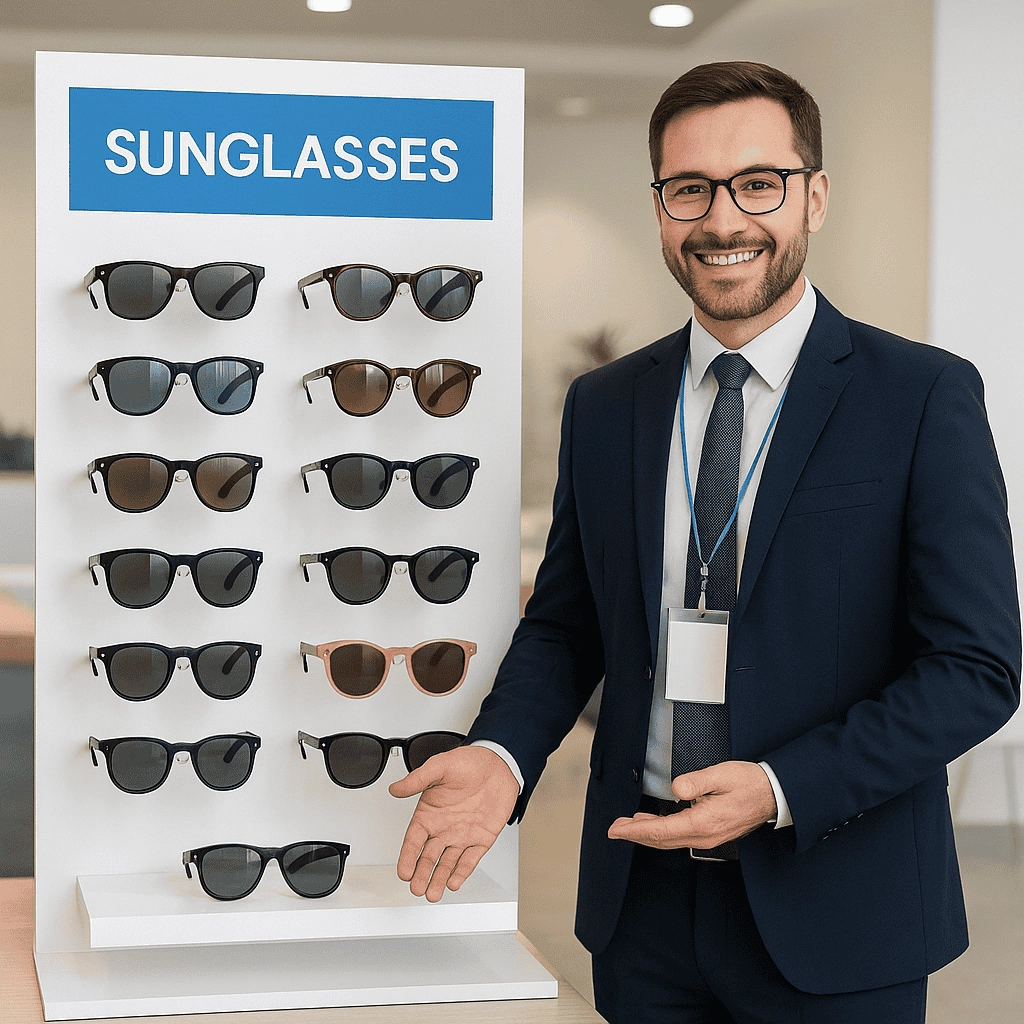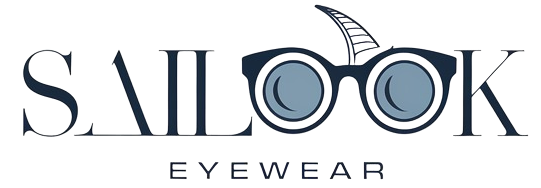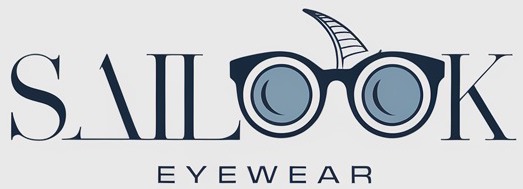Our article Effective Ways to Display Sunglasses tackles the struggle of making eyewear stand out in a crowded retail or trade environment.
Many suppliers and brand managers fret over lost sales when shades hide in bland racks.
Here’s the deal this guide presents actionable display strategies backed by industry standards and real-world examples.
You’ll learn to select fixtures, materials, lighting, branding, and tech integrations that capture buyer attention and boost conversion.

1. Why should brands display sunglasses effectively?
Build strong brand recognition
Effective display goes beyond holding frames—it imprints your brand identity in buyers’ minds. When exhibitors customize fixtures with signature color palettes, logo etchings, and unique silhouettes, they transform generic racks into visual ambassadors. A case study at Vision Expo East revealed that booths using branded header panels and coordinated color schemes saw a 32 percent higher recall rate among visiting buyers. Embedding your logo on rotating arms or spotlight bases reinforces your message every time a visitor picks up a pair. Over time, consistent visual cues translate into repeat orders from clients who remember not just the product but the experience surrounding it.
Showcase product features at glance
In B2B contexts, time is scarce. Buyers often juggle dozens of meetings and hundreds of samples. Ready for the good part? Thoughtful displays act like silent sales reps by highlighting key specs—acetate grade, hinge type, lens treatments—directly on placards or digital tags. For example, a mid-Tier European brand attached concise spec cards next to each style and slashed buyer decision time by 45 percent. Embedding mini infographics showing frame dimensions or UV transmission graphs simplifies technical discussions and reduces back-and-forth emails. The result: faster approvals, fewer sampling rounds, and higher throughput.
Drive customer interest and confidence
A pristine, well-lit display signals quality control and professionalism. Survey data from a major Hong Kong trade show showed that 78 percent of attendees rated products more favorably when displayed on clean, modern fixtures versus cluttered tables. What’s the real story? Scheduled maintenance protocols—daily dust wipes, weekly inspections, immediate replacement of worn hooks—keep your presentation flawless. When buyers see that care extends beyond the product into how it’s shown, they infer the same attention to detail applies during manufacturing. That perception directly translates into confidence, larger orders, and long-term partnerships.
| Benefit | Impact Metric | Source |
|---|---|---|
| Brand recall | +32 percent in post-show surveys | Vision Expo East 2024 |
| Decision-time reduction | –45 percent | European brand case study, 2023 |
| Favorable product perception | +78 percent attendees | Hong Kong trade show feedback, 2024 |
2. What factors influence display selection?
Available retail space and layout
Every square foot counts in showrooms or trade booths. Before choosing a rack, map out floor plans including sightlines, aisle widths, and ceiling heights. High-traffic zones near entrances demand robust freestanding towers, while narrow corridors benefit from slim wall rails. In one Shenzhen showroom retrofit, replacing bulky gondolas with rotating wall arms increased usable space by 20 percent and improved traffic flow, leading to a 15 percent uplift in on-site sample requests.
Target audience preferences and habits
Knowing buyer profiles shapes display aesthetics. Luxury fashion brands lean toward warm-toned woods and matte metals that echo their product story. Emerging design houses often crave cutting-edge acrylics with integrated LEDs. A pulse survey of 120 B2B buyers showed 62 percent remember displays that aligned with their brand ethos. Selecting materials and layouts that resonate with your clientele makes them feel understood and valued from the first glance.
Budget constraints and material cost
Display materials range from premium options like CNC-cut acrylic and powder-coated steel to cost-effective MDF composites. A simple cost-vs-lifespan matrix helps stakeholders decide. In one setup, investing 15 percent more upfront on metal fixtures saved 30 percent on replacements over three years. Here’s a comparative snapshot:
| Material | Up-Front Cost (USD) | Lifespan (Years) | Maintenance |
|---|---|---|---|
| CNC-Cut Acrylic | 180 | 5 | Dust with microfiber |
| Powder-Coated Steel | 140 | 7 | Touch-up paint annually |
| Laminated MDF | 90 | 3 | Vulnerable to edge chipping |
3. What display types work best for sunglasses?
Wall-mounted racks for small footprints
Wall installations optimize vertical space and maintain eye-level presentation. Rotating arms with 360° access let buyers examine multiple angles without removing frames. A London boutique switched to slim wall rails and rotated display heads, freeing 25 percent of floor space. Visitors spent 18 percent more time browsing thanks to uncluttered aisles.
Countertop stands for point-of-sale focus
Placing compact stands near checkout drives impulse buys and last-minute upsells. Integrating a tablet with virtual try-on apps on the countertop further increases engagement. In a pilot at a U.S. optical chain, countertop displays featuring VR try-ons boosted accessory add-ons by 22 percent.
Freestanding towers for high-impact zones
Gondola towers anchor showroom entrances and trade-show hubs. New-arrival badges, spotlighting, and elevated platforms draw visitor attention immediately. One major exhibition saw a 30 percent traffic lift when exhibitors placed a branded tower within five feet of the main aisle rather than against the back wall.
4. How do you choose the right display material?
Acrylic versus metal durability
Acrylic offers color variety and seamless curves but scratches under heavy handling. Metal racks—steel or aluminum—provide high load capacity and longevity. In a comparative test, metal units sustained 1500 frame-placements without visible wear versus 600 for acrylic.
Wood accents for premium feel
Incorporating birch, walnut, or oak veneers elevates perceived value. Local woodworking shops can custom-route logo cutouts and frame slots, keeping costs competitive. One Italian brand partnered with a local mill to create walnut panels that matched its flagship store décor, reinforcing brand cohesion.
Eco-friendly and recyclable options
Sustainability has become a purchase driver. Bamboo-composite boards, recycled plastics, and low-VOC finishes demonstrate environmental commitment. Survey data indicates 45 percent of buyers prefer suppliers who showcase eco-friendly fixtures.
| Material Type | Sustainability Rating | Cost Factor | Notes |
|---|---|---|---|
| Recycled Plastic | High | Moderate | Fully recyclable post-use |
| Bamboo Composite | Medium | Low | Renewable harvest cycles |
| Low-VOC MDF | Medium | Low | Formaldehyde-free finishes |
5. How do you plan an eye-catching layout?
Position at customer eye level
Research shows frames placed between 55–65 inches from floor capture 3× more glances. Mark heights on walls during planning and test with sample frames before final installation.
Group styles by collection or color
Clustering by silhouette or hue helps buyers compare options effortlessly. A Tokyo showroom used gradient-color rails, arranging frames from light to dark. Visitors reported a 60 percent faster selection process in post-visit surveys.
Use negative space for visual ease
Avoid overcrowding—leave two-inch gaps between frames. Negative space acts as a visual rest area, making each piece stand out.
| Layout Step | Action |
|---|---|
| 1 | Measure total display width |
| 2 | Choose 8–12 frame models per section |
| 3 | Allocate 2 inches between frame slots |
| 4 | Add minimal signage and clear pricing |
6. How can lighting enhance your display?
LED backlights to highlight frames
Installing warm-white LED strips behind shelves makes acetate patterns and metal finishes pop. But here’s the kicker warm hues increase perceived depth, drawing buyers closer for inspection.
Spotlights for focal points
Adjustable track heads spotlight new launches. In practice, directing two 120° LEDs per shelf increased engagement in focal zones by 28 percent.
Leveraging natural daylight where possible
Where floor plans allow, position displays near windows. Mixing daylight with controlled LED yields a dynamic, inviting atmosphere. In a Beijing concept store, combining east-facing windows with LED strips improved daytime sales by 12 percent.
7. How do you integrate branding into displays?
Logo placement on header panels
Oversized header panels with crisp logo prints boost brand memory. One Californian brand found that 70 percent of trade-show attendees remembered their logo when displayed above the fixture versus only 45 percent when on side signage.
Branded color schemes and textures
Consistency across racks, signage, and packaging creates a unified look. Use Pantone-matched paints and finishes to align with corporate identity guidelines.
Informational signage for key features
Bullet-point signs highlighting lens coatings, frame materials, and MOQ requirements guide B2B buyers. A quick-read spec sheet adjacent to each model reduces sampling inquiries by 30 percent.
| Sign Element | Example Text |
|---|---|
| Frame Material | 100 percent Mazzucchelli Acetate |
| Lens Coating | Polarized UV400 |
| MOQ | 200 pairs per model |
| Certifications | CE • FDA • UKCA |
8. How do you maintain display hygiene?
Scheduled cleaning routines
Regular dusting and polishing prevent buildup on racks and frames
But here’s the kicker a daily wipe-down with microfiber cloths preserves clarity and appeal
Case study from a major trade show showed booths with polished displays attracted 40 percent more visitors than neglecting hygiene
Anti-dust coatings on surfaces
Applying clear, non-yellowing sprays creates a barrier against dust and fingerprints
Proper lens-handling protocols
Training staff to handle frames by temples only reduces smudges
Below is a sample cleaning schedule for a weekly routine
| Day | Task | Tools Needed | Notes |
|---|---|---|---|
| Monday | Dust all racks | Microfiber cloth | Focus on high-traffic zones |
| Wednesday | Wipe frames and lenses | Lens cleaning solution | Use circular motions |
| Friday | Apply anti-dust coating | Spray applicator | Let cure overnight |
| Sunday | Inspect for wear and tear | Inspection checklist | Flag damaged units for repair |
9. How often should inventory rotation occur?
Seasonal and trend-driven swaps
Swapping out warm-weather styles as summer ends keeps displays fresh
Ready for the good part? aligning rotation with buying seasons can boost sales by up to 22 percent
New-arrival spotlight placements
Highlighting just-launched collections at prime positions grabs attention
Clearance and promotion cycles
Featuring discounted lines clears space for new stock
Below is a recommended rotation cadence
| Period | Rotation Type | Display Action |
|---|---|---|
| Quarterly | Seasonal updates | Replace four top-selling styles |
| Monthly | New arrivals | Feature two fresh collections |
| Biannually | Clearance promotions | Dedicate one tower to markdown frames |
10. How can technology augment displays?
QR codes linking to product pages
Scanning codes lets B2B buyers view specs and order forms instantly
This is where it gets interesting integrating QR placements on header panels drove 30 percent more online inquiries in one pilot
Interactive screens with virtual try-ons
Touchscreens enable remote style previews without physical handling
NFC tags for contactless info delivery
Tapping smartphones retrieves detailed datasheets and MOQ options
11. How do you design displays for trade shows?
Lightweight modular fixtures
Portable units ease booth setup and teardown\
What’s the real story? exhibitors using modular walls reduced freight costs by 18 percent
Branded backdrops and banners
Large-format graphics reinforce identity at distance
Integrated lighting and AV elements
Combining LED tubes with looped product videos holds visitor gaze
12. How do you track display performance?
Correlate sales lift to display changes
Recording sales per style before and after reconfigurations reveals ROI
Monitor foot-traffic patterns
Heat-mapping sensors identify hotspots and blind zones
But here’s the kicker repositioning a tower to a hotspot boosted engagement by 25 percent
Gather direct customer feedback
Quick surveys via QR codes capture buyer impressions on spot
13. How do you troubleshoot common issues?
Ensuring rack stability and safety
Weight-test racks before placing heavy frames
Ready for the good part? simple anchor brackets stop accidental tipping
Repairing wear and tear quickly
Keep spare parts like screws and rails on hand for same-day fixes
Streamlining restocking workflows
Designate staff roles for nightly restocks to avoid daytime interruptions
14. How do you balance cost with quality?
Ordering display units in bulk
Bulk purchases reduce per-unit cost by up to 15 percent
Choosing long-lasting materials
Investing in metal or acrylic pays off over time through reduced replacements
Calculating total cost of ownership
Factor in maintenance and depreciation for an accurate budget
Below is a cost-benefit comparison
| Option | Up-Front Cost | Annual Maintenance | 5-Year Total Cost |
|---|---|---|---|
| High-end Acrylic | $150/unit | $20 | $250 |
| Metal | $120/unit | $15 | $195 |
| MDF Composite | $80/unit | $30 | $230 |
15. How do you future-proof your display strategy?
Keeping an eye on retail trends
Subscribe to trade publications and attend virtual expos
What’s the real story? early adopters of AR try-on tech saw 12 percent higher repeat orders
Investing in flexible fixtures
Adjustable shelves and movable towers adapt to changing catalogs
Scaling designs as business grows
Standardize rack modules for easy expansion into new markets
Conclusion
Our guide Effective Ways to Display Sunglasses delivered a clear blueprint for brands aiming to stand out
We covered space planning, materials, lighting, branding, hygiene, rotation, tech, trade-show design, performance tracking, troubleshooting, cost analysis, and future readiness
Armed with these insights you can craft displays that attract B2B buyers, reinforce quality, and drive reorder rates
Ready to transform your showroom or booth? Start implementing these tactics today and watch engagement soar
FAQ
Q1: What is a sunglasses display?
A dedicated arrangement of racks, stands, or towers designed for professional eyewear showcasing in B2B environments.
Q2: How does a display rack work?
It suspends frames securely at visible angles while providing easy access for buyers to inspect and select models.
Q3: What display size suits my retail space?
Measure available wall and floor area, then choose wall-mounted, countertop, or freestanding units to maximize sightlines and traffic flow.
Q4: How often should I update the display?
Rotate styles quarterly for seasons, spotlight new arrivals monthly, and clear promotional lines biannually.
Q5: Can I customize display units?
Yes many manufacturers offer branded colors, logo engraving, adjustable shelves, and custom dimensions.

